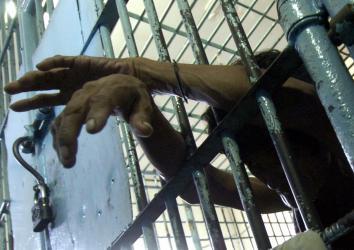In April a federal indictment revealed that members of a prison gang called the Black Guerrilla Family had effectively taken control of the Baltimore City Detention Center. (I wrote about this case here and here.) They were allegedly aided by corrupt corrections officers (COs)—some of whom had become romantically involved with certain gang members—who smuggled drugs, cellphones, and other illicit material into the jail for the gang’s benefit. Now, an affidavit in the case provides new details on how the smuggling operation worked.
The document makes for fascinating reading, and could function as a best-practices manual for prisoners looking to set up a smuggling operation of their own. (Or, I suppose, a manual for wardens who want to put an end to such shenanigans.) Forget shooting weed into the exercise yard with a bow and arrow, or baking a file into a cake: If you want your scheme to succeed over the long term, here’s what you need to do.
Identify willing guards. Identifying and suborning pliant corrections officers is key to any successful jailhouse smuggling scheme. The affidavit in the Baltimore case asserts that “new BGF recruits are taught to target a specific stereotype of a CO, specifically women with low self-esteem, insecurities, and certain physical attributes.” The BGF members then attempt to seduce these women, and the relationships build from there. Male COs are more apt to be swayed by money than sexual advances; the affidavit alleges that one indicted male guard “would make $3,000-$5,000 a week smuggling contraband to one inmate.” That’s a lot of money for anyone, but especially for a low-paid corrections officer who knows that half of his co-workers are already on the take.
Refine your smuggling methods. After a CO has been turned, he or she still has to find a way to bring the contraband inside the facility. The affidavit alleges that corrupt COs did this by “hiding it on their person, concealing it in their clothing, disguising it in food items,” and other methods that exploited weak spots in the BCDC’s security protocols. Though guards were patted down every day before work, at least one CO found a novel workaround; the affidavit alleges that “one CO inserted an ounce of marijuana into her vagina every day before work for a period of several years and also carried a pouch of tobacco or Percoset pills concealed in her underwear.” If the contraband doesn’t fit inside your body, it might fit inside your lunch: The affidavit notes that “cell phones are routinely smuggled into the jail inside sandwiches which avoid detection.”
Get the “good prisoners” on your side. Almost every jail or prison has its share of well-behaved inmates who perform jobs that allow them greater freedom of movement within the facility. In the Baltimore City Detention Center, according to the affidavit, 95 percent of these “working men” were BGF members who served as contraband couriers; they used their access to pick up goods that had been stashed in certain areas of the prison, and then transport those goods to their intended recipients. Without these inmates’ cooperation, the smuggling scheme would have ceased to function.
By following these protocols, the Black Guerrilla Family was allegedly able to build a jailhouse smuggling system that was impressive in its audacity. Now that these indictments have come down, though, the Baltimore City Detention Center has tightened up, and inmates have been forced to employ other, less impressive methods for acquiring contraband. Justin George at the Baltimore Sun wrote last week that two people had been arrested after they were observed attempting to smuggle marijuana into the BCDC by attaching it to a rope that had been thrown down from a top-floor window. How the mighty have fallen.
